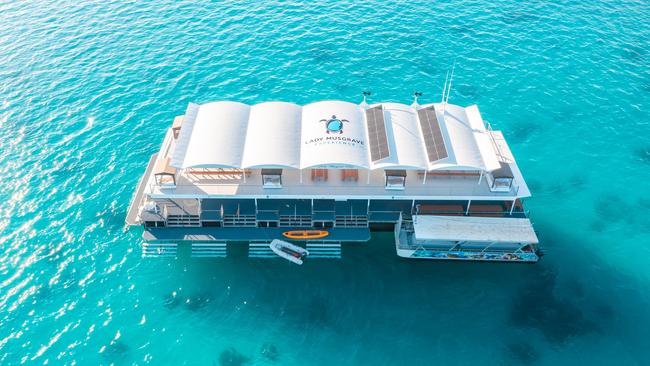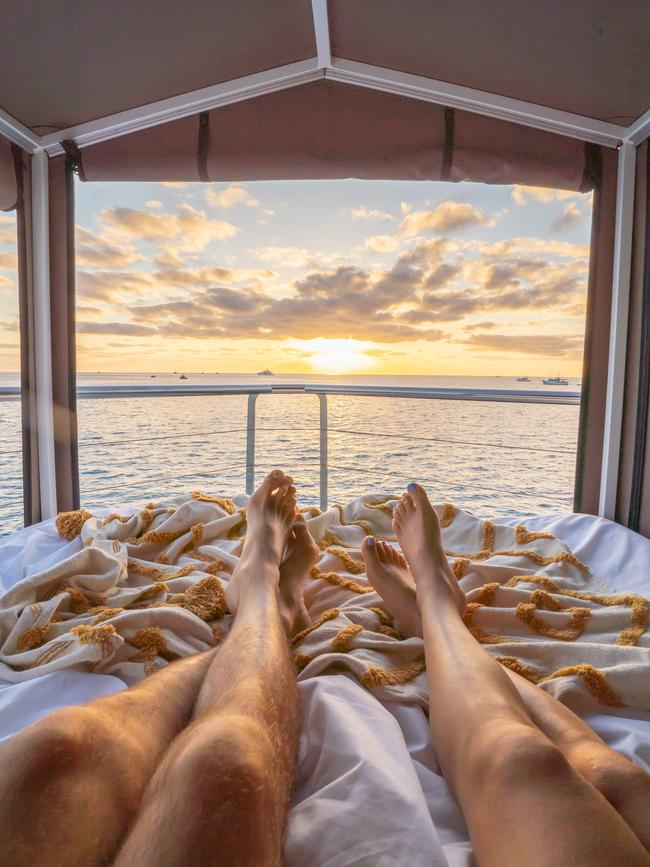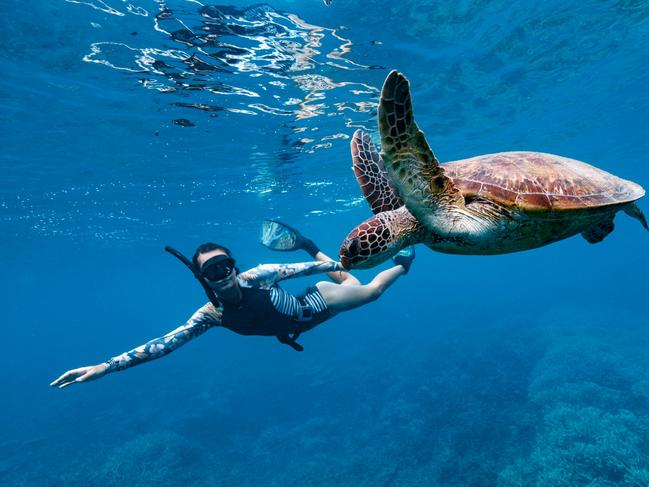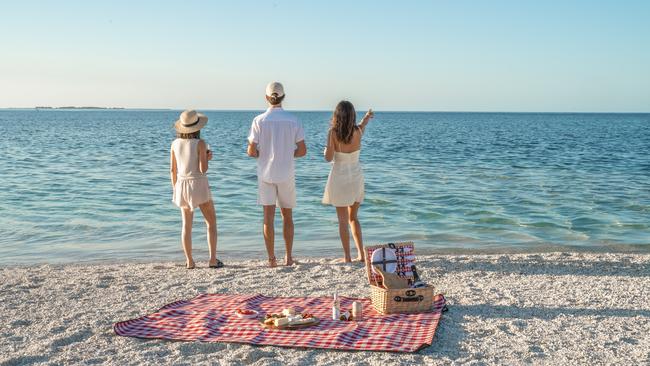Lady Musgrave Island pontoon launches overnight accommodation
If glamping floats your boat, and you like exploring the reef, this new attraction offers the best of both worlds.

Few experiences are as uplifting as sharing a pre-breakfast swim with a turtle. Pre-breakfast for me, at least: this hawksbill is already grazing, nibbling on seagrass at the edge of the southern Great Barrier Reef. She acknowledges my presence with an insouciant turn of her head, then decides to forage further east, flippers propelling her through water with the grace and ease of a bird’s wings through air. I follow for 10 minutes as she choreographs a slow-motion dance over rosette-shaped corals and giant clams; through schools of baitfish and glittering blue and green chromis.
She snaps at a jellyfish, its translucent body barely visible as the morning rays penetrate the surface. Somehow, that breaks the spell. She suddenly shoots off into the deeper blue waters beyond, where we’ve been told not to venture, and I realise that not only are these moments of enchantment with a wild beast over, but my legs are aching with exertion and my stomach is rumbling.

I swim back to Lady Musgrave HQ, a new $4m pontoon moored adjacent to its namesake Lady Musgrave Island. Surrounded by almost 1200ha of fringing reefs, this coral cay is known to its traditional owners as Wallaginji, meaning “beautiful reef”. It is part of the Bunker group, named in 1803 by Captain Eber Bunker, and subsequently dubbed “Bunker number one”. Later, colonial Queensland governor Anthony Musgrave renamed the island after his wife. It has since served as a guano mine (1890s), tourist resort (1930s) and small campsite and stopping off point (today).
Founder of Lady Musgrave Experience Brett Lakey has been running boat tours to and around the island since 2015, but the 35m-long pontoon, designed to provide a modicum of comfort for overnight guests, has been in place only since September. He points out that while Lady Musgrave HQ is not the only spot you can sleep surrounded by fish and coral, its location is unique. “We’ve got the only island on the entire Great Barrier Reef that has a navigable lagoon,” he says.
The fragility of the reef as a whole meant there were some challenges getting the project over the line. The pontoon had to be positioned to avoid shading the surrounding reefs, for example, while the stabilising concrete blocks were also carefully placed. Lady Musgrave HQ is completely wind and solar-powered, and wastewater is stored in the hull and transferred back to the mainland.

Getting to the pontoon requires a two-hour journey aboard a high-speed catamaran called the Reef Empress, a ride so rough in places that operators recommend taking seasickness tablets. “It’s like riding a horse,” one fellow traveller remarks, clinging to the balustrade. Inside the sheltered lagoon, though, the waters are clear, calm and teeming with marine life, including soft and hard corals, anemones, tropical fish, manta rays and reef sharks.
Unofficially, though, we’re all hoping for turtles. We’ve arrived during peak breeding season, when three of the world’s seven species of sea turtles – green, hawksbill and loggerhead – are thick in the water. Leatherbacks have also been spotted recently, but they are far less common here, says marine scientist Sanna Rigbye. She encourages snorkellers seeking turtle encounters to play it cool. “They are very fast under water and they will swim away from you,” she explains. “But if you just hang out a bit, they’re really curious, and they might actually come up to you.”

Once on board the 350-person capacity pontoon, which features an underwater observatory where guests can watch marine life swim by, we’re put in groups to ease the load on different activities. Members of my gang climb aboard a glass-bottomed boat and then take a short walking tour of the island, a primitive, paradisical place. From October to March, 50 to 100 turtles lumber up the beach each night to lay their eggs here. We crunch on coral rubble lining the shore and make our way into the shady interior, where tens of thousands of black noddy terns nest in shady Pisonia trees.
A buffet lunch of cold meats and salads follows, then it’s time to hit the water. Here, things get a little frenetic, as people clamour for equipment and territory, and crew members blow a whistle to signal infringements like swimming out of bounds or abandoning floating devices. But just after 2pm, the day-trippers climb back on the catamaran to return to the mainland, leaving silence and serenity in their wake. It’s as if the whole reef breathes a sigh of relief.
Sleepover guests have the lagoon to themselves until the next day’s boat arrives. It’s a heady feeling. I swim alongside a school of long toms, photograph clownfish and visit a turtle cleaning station, where remoras and other small fish remove parasites from their shells. Afterwards, I head upstairs to one of eight glamping beds, queen-sized mattresses enclosed in canvas canopies that can be zipped shut or opened up. I watch as the receding tide slowly exposes the reef flat before heading back downstairs for a dinner of beef cheek with pumpkin risotto.

An unexpected storm blows in later that night. Fortunately, the beds are equipped with castors, allowing guests to move them to more sheltered spots under the roofline. Ensconced in my tent, amid lashing rain and driving winds, it’s not the “sleeping under the stars” experience I was expecting. Nevertheless, I feel utterly immersed in nature, as much a part of the environment as the terns and the turtles. I fall asleep listening to the creaks and groans of the pontoon’s joints, secure in the knowledge that the structure is built to withstand a category three cyclone.
The storm clears by morning, so I roll up the canvas on one side for a view of Lady Musgrave Island. A dark oval shape moves under the water below, before the leathery head of a turtle emerges to take a breath. Then another. And another. The storm has brought in jellyfish, which have in turn attracted turtles. The opportunity to swim with them again is irresistible. I don mask, snorkel and fins, and plunge into the sea.

In the know
Lady Musgrave Island is 51 nautical miles from Bundaberg, a city known for its sugar mills, distilleries, fertile soils and emerging farm gate trails. Two-night stays in Lady Musgrave HQ’s glamping beds start at $900 a person, twin-share, including boat transfers, meals, snorkelling equipment hire and linen. Additional dorm-style accommodation is available in the underwater observatory below deck. Toilet and shower facilities are shared; total guest numbers are capped at 30.
Denise Cullen was a guest of Tourism and Events Queensland.
